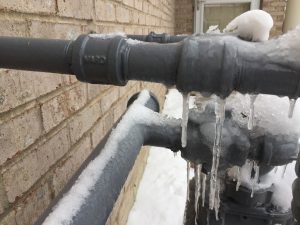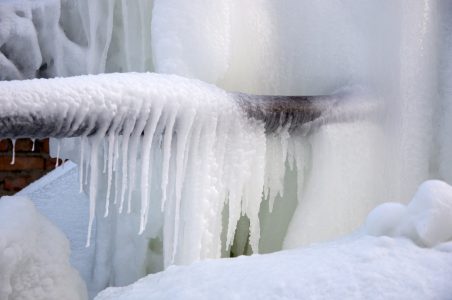We have encountered this article relating to Prevent Frozen Pipes below on the net and believe it made good sense to relate it with you over here.

Winter can wreak havoc on your plumbing, particularly by freezing pipes. Below's exactly how to prevent it from taking place and what to do if it does.
Intro
As temperatures decrease, the danger of frozen pipelines rises, potentially leading to expensive repair services and water damages. Recognizing exactly how to avoid frozen pipelines is vital for property owners in chilly environments.
Prevention Tips
Shielding prone pipelines
Cover pipes in insulation sleeves or make use of heat tape to safeguard them from freezing temperatures. Focus on pipelines in unheated or external areas of the home.
Heating methods
Maintain interior spaces effectively heated, particularly areas with pipes. Open up cabinet doors to allow warm air to circulate around pipelines under sinks.
Just how to determine frozen pipes
Search for lowered water flow from faucets, unusual smells or sounds from pipes, and noticeable frost on exposed pipes.
Long-Term Solutions
Structural modifications
Think about rerouting pipelines away from outside wall surfaces or unheated areas. Include added insulation to attics, basements, and crawl spaces.
Updating insulation
Invest in high-quality insulation for pipes, attic rooms, and wall surfaces. Correct insulation assists keep consistent temperature levels and reduces the danger of frozen pipes.
Safeguarding Exterior Plumbing
Yard tubes and exterior faucets
Detach and drain pipes garden tubes before winter. Set up frost-proof spigots or cover outside faucets with shielded caps.
Comprehending Frozen Pipelines
What triggers pipelines to ice up?
Pipes freeze when subjected to temperatures listed below 32 ° F (0 ° C) for extended periods. As water inside the pipelines freezes, it broadens, taxing the pipe walls and potentially creating them to rupture.
Dangers and problems
Icy pipes can cause water supply disturbances, residential property damage, and expensive fixings. Ruptured pipelines can flood homes and trigger substantial architectural damages.
Indications of Frozen Water Lines
Determining frozen pipelines early can prevent them from bursting.
What to Do If Your Pipes Freeze
Immediate activities to take
If you presume icy pipes, keep faucets open up to relieve stress as the ice melts. Utilize a hairdryer or towels taken in hot water to thaw pipes slowly.
Verdict
Protecting against icy pipes calls for positive procedures and quick actions. By comprehending the reasons, indications, and safety nets, home owners can safeguard their pipes during cold weather.
6 Proven Ways to Prevent Frozen Pipes and Protect Your Home
Disconnect and Drain Garden Hoses
Before winter arrives, start by disconnecting your garden hoses and draining any remaining water. Close the shut-off valves that supply outdoor hose bibs and leave the outdoor faucet open to allow any residual water to drain. For extra protection, consider using faucet covers throughout the colder months. It’s also important to drain water from any sprinkler supply lines following the manufacturer’s directions.
Insulate Exposed Pipes
Insulating your pipes is an effective way to prevent freezing. Pipe insulation is readily available at home improvement stores and is relatively inexpensive. Pay close attention to pipes in unheated areas such as the attic, basement, crawl spaces, or garage. Apply foam insulation generously to create a buffer against the cold. You can also wrap your pipes in heat tape or thermostat-controlled heat cables for added warmth.
Seal Air Leaks
Inspect your home for any cracks or openings that could let in cold air. Seal any holes around the piping in interior or exterior walls, as well as the sill plates where your home rests on its foundation. Additionally, make sure to keep your garage door closed unless you’re entering or exiting. Leaving it open creates a significant air leak that can lead to frozen pipes.
Allow Warm Air Circulation
During cold snaps, it’s essential to allow warm air to circulate evenly throughout your home. Leave interior doors ajar to promote better airflow. Open kitchen and bathroom cabinets to help distribute heat consistently around the rooms. If you have small children or pets, be sure to remove any household chemicals or potentially harmful cleaners from open cabinets for safety.
Let Faucets Drip
A small trickle of water can make a big difference in preventing ice formation inside your pipes. When temperatures drop significantly, start a drip of water from all faucets served by exposed pipes. This continuous flow helps prevent the water from freezing. Additionally, running a few faucets slightly can relieve pressure inside the pipes, reducing the chances of a rupture if the water inside does freeze.
https://choateshvac.com/6-proven-ways-to-prevent-frozen-pipes-and-protect-your-home/

We hope you enjoyed our section about Prevent Frozen Pipes . Thank you for finding the time to read through our article post. Sharing is nice. You never know, you may just be doing someone a favor. I cherish reading our article about How To Avoid Freezing Pipes.
Set Up An Appointment
Comments on “Tips to Avoid Frozen Pipes in Cold Weather: Pro Tips”